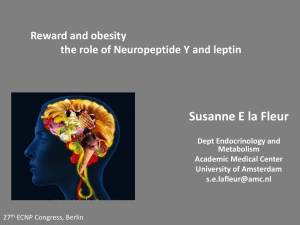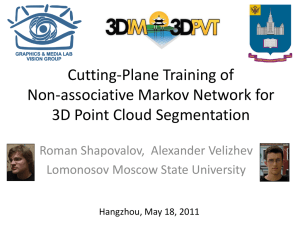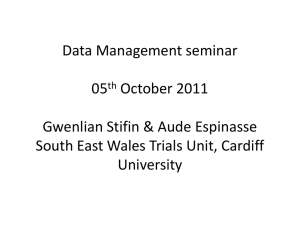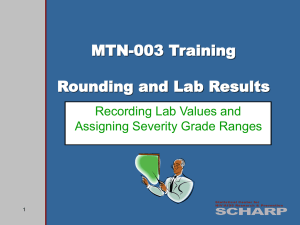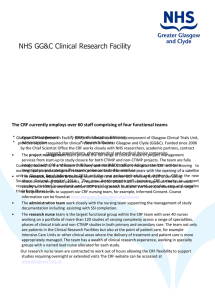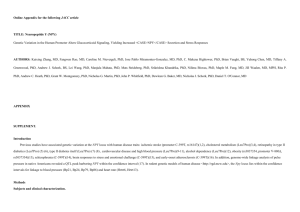Neuropeptide Y and corticotropin-releasing factor bi
advertisement
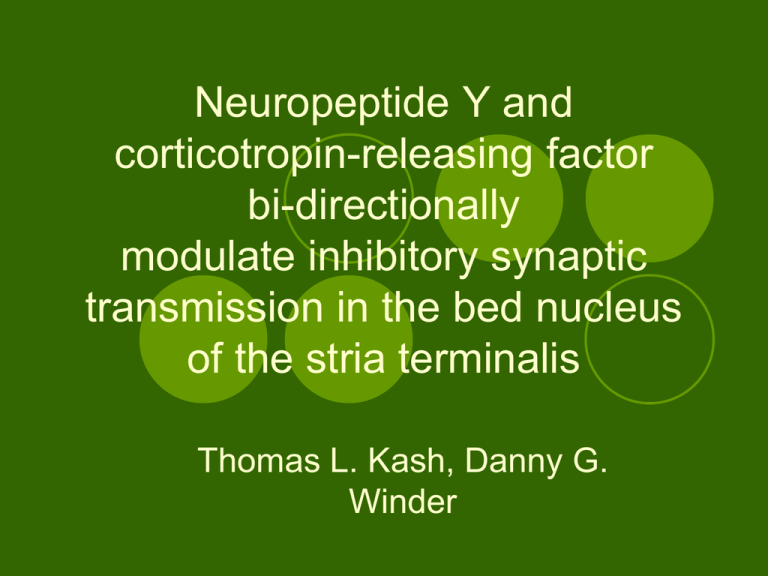
Neuropeptide Y and corticotropin-releasing factor bi-directionally modulate inhibitory synaptic transmission in the bed nucleus of the stria terminalis Thomas L. Kash, Danny G. Winder Introduction Neuropeptides (NPY) = potent neuromodulators in the CNS Involved in reward pathway mediated via G-protein coupled receptors released in a frequency dependent fashion longer half-life of activity after release Introduction Corticotropin Releasing Factor (CRF) involved in stress response Mediated through the hypothalamus and the amygdala Both pathways converge at the BNST Introduction Life = Stress Repeated or severe stressors can produce behaviors such as posttraumatic stress disorder and generalized anxiety disorder BNST provides a substrate for interaction of CRF and NPY in regulating stress and anxiety Introduction NPY Anxiety ↓ Reward pathway CRF Anxiety ↑ Stress response BNST acts as a scale to create a balance of CRF and NPY Neves S, Ram P, Iyengar R. G protein pathways. Science 296, 1636-1639 (2002) Introduction BNST expresses both NPY/YRs and CRF/CRFRs CeA releases CRF and GABA to the BNST Both CRF and NPY modulate GABAergic transmissions Introduction Study GABAergic influence on ventrolateral region of the BNST vlBNST projects to the VTA (reward) and the PVN (stress) Introduction IPSC= inhibitory post-synaptic current m = miniature e = evoked Methods Male C57B1/6J mice Decapitated mice and placed brain in icecold sucrose aCSF Slices 300um thick Rostral slices contained anterior BNST Stored in heated, oxygenated container w/ aCSF Transferred to submerged recording chamber Heated, O2 aCSF for 1h ā experiments Methods Slices in chamber and neurons of vlBNST visualized w/ infrared video microscopy Analyzed eIPSC & EPSC Electrodes filled w/ pH 7.2 Twisted nichrome wire Placed in vlBNST Cells held @ -50mV & GABAAR-mediated IPSCs evoked @ 0.2 Hz by fiber stim w/ bipolar electrodes Methods GABAA-IPSCs (& EPSC) isolated 3mM kynurenic acid (& 25uM picrotoxin) = block AMPA & NMDA receptor-dependent postsynaptic currents 1uM CGP 55845 = block GABABR Signals acquired via Multiclamp 700B amplifier Input and series resistance continuously monitored Methods eIPSC → measured peak amplitude of synaptic response normalized to baseline Baseline period = 2 min period immediately preceding drug Value is 2 min avg 15 min p neuropeptide B 0 3 * peptide 5 10 15 20 22 Methods mIPSC analysis GABAAR-mediated IPSCs isolated → added 0.5uM TTX recorded in 120s episodes Ca2+ influx on NPY → 100uM Cd2+ + aCSF Amplitude and frequency determined from 120s recording w/ cells held @ -70mV Multi-clamp Methods All drugs applied via bath All peptides used were dissolved in dH2O to 0.1mM conc Some stored @ -20°C Results NPY and CRF influence on inhibitory synaptic transmission in vlBNST Whole-cell voltage clamp Local stimulation produced eIPSC from GABAARs SR95531= GABAAR antagonist blocked response Results TTX elicited spontaneous mIPSCs GABAzine = GABAAR antagonist mIPSCs blocked GABAAR mediated Results NPY depresses GABA through Y2R Baseline recordings revealed decreased peak amplitude of eIPSC Observed in all cells NPY-induced depression = concentration dependent Results NPY13-36 = Y2R agonist ↓ peak amplitude [Pro34]-NPY = Y1R agonist & [D-Trp32]-NPY = Y5R agonist No change Results Antagonist testing was preceded by an exposure to NPY (10-15min) Agonist and antagonist co-applied (5min) NONE had significant effects on eIPSC without agonist Results Non-peptide Y2R antagonist blocked NPY actions Peptide Y1R antagonist had no effect Non-peptide Y5R antagonist had no effect Y2Rs activated NPY-induced eIPSC depression Results Paired Pulse Ratio experiments Pair of eIPSCs w/ 50ms between Ratio of amplitudes determined NPY ↑ PPR of eIPSCs Suggest ↓ release of GABA NPY ↓ frequency but not amplitude Results Presynaptic inhibition of NT release Modulate Ca2+ entry Regulate release machinery At CNS synapse basal mIPSC freq ↓ by using Cd2+ to block Vg Ca2+ channels Cd2+ + NPY = restores mIPSCs NPY inhibits GABA via Y2R regulation of Ca2+ influx Results 5 min bath of 1um CRF sig ↑ peak amp of eIPSC 1um Urocortin (CRFR agonist) → similar results CRF results were concentration dependent [100nM vs 10nM] CRF antagonist had no sig effects on eIPSC in absence of agonist Results Non-peptide CRFR1 antagonist (NBI 27914) blocked both CRF and Ucn I actions Peptide CRFR2 antagonist (antiSauvagine-30) had no sig effect Ucn I enhanced eIPSCs in CRFR2 knockout mice So, CRF/Ucn I induced enhancement of eIPSC is d/t CRFR1 activation Results CRF did not alter PPR or mIPSC kinetics no effect on freq of mIPSCs Mean amplitude ↑↑ Shifted cum. amplitude curve to the right CRF enhanced GABAergic postsynaptic transmission Change in IPSCs d/t non-specific enhancement via synaptic excitability Discussion NPY suppresses GABAergic transmission in vlBNST via Y2R: 1. NPY effect mimicked by NPY13-36, not by [Pro34]-NPY (Y1 agonist) or [DTrp32]-NPY (Y5 agonist) 2. NPY antagonized by Y2R antagonist (BIEE 0246), not by BVD-10 (Y1R antagonist) or L-152804 (Y5R antagonist) Discussion Data consistent w/ NPY actions in thalamus & PVN and Y2R expression in BNST Y2R ↓ GABA release: 1.NPY ↑ PPR of eIPSCs → ↓ release probability 2.NPY ↓ mIPSC frequency not amplitude 3.Cd+2 effect → NPY via Y2R inhibit GABA via presynaptic Ca+2 influx Discussion NPY via Y2R → heterocepter on GABAergic terminals Which YR is activated determines the behavioral outcome Y1R and maybe Y5R → NPY anxiolytic response Y2R → anxiogenic response But, Y2R activation in LC → NPY anxiolytic effects Discussion Suppose region-specific activation of YR subtypes will evoke distinct behavioral phenotypes, OR… Autoreceptor-like functions are anxiolytic Discussion Based on evidence that inhibitory projections from the vlBNST contact PVN neurons: ↓ GABAergic input to vlBNST → ↑ GABAergic output to PVN → ↓ stress response Discussion In the vlBNST, CRF and Ucn I enhance GABAergic transmission via CRFR1: 1.CRF & Ucn I antagonized by NBI 27914 (CRFR1), not AS 30 (CRFR2) 2.Ucn I effects observed in mice lacking CRFR2 3.CRFR1 enhance postsynaptic GABAA-R response Discussion CRF ↑ mIPSC amplitude not frequency or PPR Glutamatergic transmission in vlBNST not affected by Ucn I Presynaptic CRFR1 mediates GABAergic transmission in CeA Altering mIPSC frequency modulates GABA release → now amplitude as well Discussion CRFR1 mediates CRF anxiogenic effects in the BNST CRF enhancing GABAergic transmission in BNST could potentially reactivate the PVN → stress response
